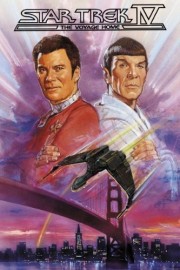Star Trek IV: The Voyage Home
Although it is in the middle of a much larger franchise of films, “Star Trek” had its own trilogy of films in the ’80s, one that, I would argue, rivals the original “Star Wars” trilogy in entertainment value, if not in quality. It’s not far off on that front, however.
This story arc began with “The Wrath of Khan” in 1982, which dovetailed into “The Search for Spock” in 1984, the events of which lead into the final film, “The Voyage Home.” This was the second film directed by Leonard Nimoy, who had also helmed “The Search for Spock,” and he does an, arguably, superior job this time around. He has richer material to run with, as well: he conceived of the story with producer Harve Bennett, and the script was written by Bennett, Steve Meerson, Peter Krikes, and Nicholas Meyer, the director of “Wrath of Khan.” Apart from being a great science fiction premise, there’s also a deep vein of comedy that was unexpected at the time, and allows “The Voyage Home” to remain one of “Star Trek’s” best film offerings.
The film starts with the arrival of an alien probe. It emits an unusual signal that not only has the power to shut down electronics, but is also unable to be deciphered by 23rd century humanity. It is in this moment of distress when Admiral Kirk and the crew of the recently-destroyed Enterprise are returning to Earth in the Klingon attack ship they took over in “Search for Spock,” to accept the punishments of the crimes they committed in saving their comrade from the Genesis planet. Still not quite himself from his life and death situation, Spock nonetheless figures out that the basic signal is the song of humpback whales, which are extinct in the 23rd century. That leads the crew to have a crazy idea involving traveling back to the late part of the 20th century to find humpback whales, and bring them to their time to communicate. They end up in 1980s San Francisco, and needless to say, there’s a bit of culture shock when they try and figure out all of their problems, especially with a Vulcan in tow.
While Nimoy hasn’t made any bones about the obvious environmental message of the film over the years, it’s not a heavy-handed one in the least. The context of that part of the story with the sci-fi element of the film helps place “The Voyage Home” firmly in the tradition of philosophical, speculative sci-fi that “Trek” is best known for. That the whales themselves are so important to the story, and introduced (along with their keeper, played by Catherine Hicks) so early in the film, helps with the immediacy of the story, not only from the crew’s standpoint, but the whales’s. If they are left in captivity, their odds of survival are as bad as they would be if they are sent into the ocean; in a way, the need for them in the 23rd century is their best hope for survival, even if it means uncertainty for the crew’s return trip. This symbiosis ties in wonderfully with the main theme that spreads throughout this trilogy of “Trek” films, that “the needs of the many, outweigh the needs of the few, or the one.” Whether it was intentionally planned out that way, I don’t know, but it works nonetheless.
There’s more to this film than just “the message,” though, and that’s where the humor comes into play. This is a typical fish-out-of-water tale when the crew is in 1980s San Francisco, and while it’s entertaining, especially seeing Spock try to assimilate, seeing it again, the film does feel dated given its specific time period. Still, the cast has fun with this material, and while it may seem a bit forced at moments, it makes for an entertaining, and unusual, entry into this venerable sci-fi franchise, with the larger story ensuring it’s status as a classic “Star Trek” entry.










